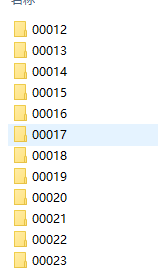热门标签
热门文章
- 1多线程之AQS_多线程aqs
- 2实时数据库迁移
- 3【微服务】skywalking自定义告警规则使用详解_skywalking include-names实体旻城列表
- 4微信小程序需要ajax吗,在微信小程序中封装自己的ajax
- 5汽车自动驾驶产业链深度研究报告:自动驾驶驶向何方_云计算产业链上下游在自动驾驶行业的应用
- 6vue3.0中从proxy中取值_proxy 取值
- 7使用GitZip下载GitHub指定文件
- 8在执行第一次执行react-native run-android时,下载.gradle特别特别慢解决办法_run-android时候下载资源慢
- 9百面嵌入式专栏(面试题)驱动开发面试题汇总 2.0
- 10【HarmonyOS】【DevEco Studio】ohpm安装失败该如何解决?_execute install task failed, component ohpm.zip. e
当前位置: article > 正文
深度学习 基于TensorFlow的植物图像识别及其可视化界面设计_基于图像识别的植物识别代码
作者:IT小白 | 2024-02-25 10:15:19
赞
踩
基于图像识别的植物识别代码
该小项目的最终的界面如图所示:

本项目中的所有植物图像均为自己拍摄,一共12种植物,每种1250张,共15000张。网络采用VGG-16,Resnet50,ALEXNET,可以随便切换网络进行训练。
本文仅供大家学习讨论,本人也是参考了很多位大佬的程序,如有错误还请大家指正。
如需完整代码还请支持一下我这个艰难的求学者,不为赚钱,谨为改善学习和生活的条件,真心感谢:
下面介绍相关实现部分(不含GUI界面的代码,GUI使用Pyqt5编写)
首先导入各种包
- import logging
- import os
- import pickle
- import random
- import time
-
- import numpy as np
- import tensorflow as tf
- import tensorflow.contrib.slim as slim
- from PIL import Image
所有图像按照如下方式进行分类,每一个文件夹五位数,最后两位为品种编号,代表一种植物图像,每种文件夹内的图像按照如下方式进行命名,即前两位与文件夹名称保持一致,后三位从000-999为个体编号。图像大小均为224*224*3.


对图像的label进行读取,遍历整个文件夹获取图像的名称,前两位就是图像的label,相关代码实现如下。
- def __init__(self, data_dir):
- truncate_path = data_dir + ('%05d' % FLAGS.charset_size)
-
- self.image_names = []
- for root, sub_folder, file_list in os.walk(data_dir):
- print(root)
- if root < truncate_path:
- self.image_names += [os.path.join(root, file_path) for file_path in file_list]
- random.shuffle(self.image_names)
- print(self.image_names)
- self.labels = [int(file_name[len(data_dir):].split(os.sep)[0]) for file_name in self.image_names]
- print(self.labels)
为了解决图像数据集过少的问题,引入了图像增强操作扩充数据集,使用随机上下、左右翻转、在一定范围内随机调整亮度、对比度、饱和度、色相等。可以按需要开启关闭或者调参。
- def data_augmentation(images):
- if FLAGS.random_flip_up_down:
- images = tf.image.random_flip_up_down(images)
- if FLAGS.random_flip_left_right:
- images = tf.image.random_flip_left_right(images)
- if FLAGS.random_brightness:
- images = tf.image.random_brightness(images, max_delta=0.1)
- if FLAGS.random_contrast:
- images = tf.image.random_contrast(images, 0.9, 1.1)
- if FLAGS.resize_image_with_crop_or_pad:
- images = tf.image.resize_image_with_crop_or_pad(images, FLAGS.image_size, FLAGS.image_size)
- if FLAGS.random_saturation:
- images = tf.image.random_saturation(images, 0.9, 1.1)
- if FLAGS.random_hue:
- images = tf.image.random_hue(images, max_delta=0.1)
- return images

构造批处理队列,将label放入队列中。
- def input_pipeline(self, batch_size, num_epochs=None):
- images_tensor = tf.convert_to_tensor(self.image_names, dtype=tf.string)
- labels_tensor = tf.convert_to_tensor(self.labels, dtype=tf.int64)
- input_queue = tf.train.slice_input_producer([images_tensor, labels_tensor], num_epochs=num_epochs)
- labels = input_queue[1]
- images_content = tf.read_file(input_queue[0])
- images = tf.image.convert_image_dtype(tf.image.decode_jpeg(images_content, channels=3), tf.float32)
- images = self.data_augmentation(images)
- new_size = tf.constant([FLAGS.image_size, FLAGS.image_size], dtype=tf.int32)
- images = tf.image.resize_images(images, new_size)
- image_batch, label_batch = tf.train.shuffle_batch([images, labels], batch_size=batch_size, capacity=150,
- min_after_dequeue=10)
- return image_batch, label_batch
神经网络部分就跳过了,接着就是返回一些相关参数,比如准确率、topk,loss,step等等一系列的。
- def build_graph(top_k):
- with tf.device('/gpu:0'):
- keep_prob = tf.placeholder(dtype=tf.float32, shape=[], name='keep_prob')
- images = tf.placeholder(dtype=tf.float32, shape=[None, FLAGS.image_size, FLAGS.image_size, FLAGS.pic_channel],
- name='image_batch')
- labels = tf.placeholder(dtype=tf.int64, shape=[None], name='label_batch')
- logits = cnn(images)
- with tf.device('/gpu:0'):
- with tf.name_scope("loss"):
- loss = tf.reduce_mean(tf.nn.sparse_softmax_cross_entropy_with_logits(logits=logits, labels=labels))
- with tf.device('/gpu:0'):
- with tf.name_scope("accuracy"):
- accuracy = tf.reduce_mean(tf.cast(tf.equal(tf.argmax(logits, 1), labels), tf.float32))
- global_step = tf.get_variable("step", [], initializer=tf.constant_initializer(0.0), trainable=False)
- rate = tf.train.exponential_decay(2e-4, global_step, decay_steps=2000, decay_rate=0.97, staircase=True)
- update_ops = tf.get_collection(tf.GraphKeys.UPDATE_OPS)
- with tf.control_dependencies(update_ops):
- train_op = tf.train.AdamOptimizer(learning_rate=rate).minimize(loss, global_step=global_step)
- with tf.name_scope("probabilities"):
- with tf.device('/gpu:0'):
- probabilities = tf.nn.softmax(logits)
- predicted_val_top_k, predicted_index_top_k = tf.nn.top_k(probabilities, k=top_k)
- accuracy_in_top_k = tf.reduce_mean(tf.cast(tf.nn.in_top_k(probabilities, labels, top_k), tf.float32))
- tf.summary.scalar('loss', loss)
- tf.summary.scalar('accuracy', accuracy)
- tf.summary.scalar('top_k', accuracy_in_top_k)
- merged_summary_op = tf.summary.merge_all()
- return {'images': images,
- 'labels': labels,
- 'keep_prob': keep_prob,
- 'top_k': top_k,
- 'global_step': global_step,
- 'train_op': train_op,
- 'loss': loss,
- 'accuracy': accuracy,
- 'accuracy_top_k': accuracy_in_top_k,
- 'merged_summary_op': merged_summary_op,
- 'predicted_distribution': probabilities,
- 'predicted_index_top_k': predicted_index_top_k,
- 'predicted_val_top_k': predicted_val_top_k}

随后开启回话进行训练,保存模型,写入log。
- def train():
- print('Begin training')
- train_feeder = DataIterator(data_dir=FLAGS.train_data_dir)
- test_feeder = DataIterator(data_dir=FLAGS.test_data_dir)
- with tf.Session() as sess:
- train_images, train_labels = train_feeder.input_pipeline(batch_size=FLAGS.batch_size, num_epochs=FLAGS.epoch)
- test_images, test_labels = test_feeder.input_pipeline(batch_size=FLAGS.batch_size)
- graph = build_graph(top_k=5)
- sess.run(tf.global_variables_initializer())
- sess.run(tf.local_variables_initializer())
- coord = tf.train.Coordinator()
- threads = tf.train.start_queue_runners(sess=sess, coord=coord)
- saver = tf.train.Saver()
- train_writer = tf.summary.FileWriter(FLAGS.log_dir + '/train', sess.graph)
- test_writer = tf.summary.FileWriter(FLAGS.log_dir + '/test')
- start_step = 0
- if FLAGS.restore:
- ckpt = tf.train.latest_checkpoint(FLAGS.checkpoint_dir)
- if ckpt:
- saver.restore(sess, ckpt)
- print("restore from the checkpoint {0}".format(ckpt))
- start_step += int(ckpt.split('-')[-1])
- logger.info(':::Training Start:::')
- try:
- while not coord.should_stop():
- start_time = time.time()
- train_images_batch, train_labels_batch = sess.run([train_images, train_labels])
- feed_dict = {graph['images']: train_images_batch,
- graph['labels']: train_labels_batch,
- graph['keep_prob']: 0.8}
- _, loss_val, accuracy_train, train_summary, step = sess.run([graph['train_op'],
- graph['loss'],
- graph['accuracy'],
- graph['merged_summary_op'],
- graph['global_step']], feed_dict=feed_dict)
- train_writer.add_summary(train_summary, step)
- # print(train_labels_batch)
- # Ending time
- end_time = time.time()
-
- logger.info("the step: {0} takes {1}s loss: {2} accuracy: {3}%".format(round(step, 0),
- round(end_time - start_time,
- 2), round(loss_val, 2),
- round(accuracy_train * 100,
- 2)))
- if step > FLAGS.max_steps:
- break
-
- if step % FLAGS.eval_steps == 1:
- test_images_batch, test_labels_batch = sess.run([test_images, test_labels])
- feed_dict = {graph['images']: test_images_batch,
- graph['labels']: test_labels_batch,
- graph['keep_prob']: 1.0}
- accuracy_test, test_summary = sess.run([graph['accuracy'],
- graph['merged_summary_op']], feed_dict=feed_dict)
- test_writer.add_summary(test_summary, step)
-
- logger.info('======================= Eval a batch =======================')
- logger.info('the step: {0} test accuracy: {1} %'.format(step, round(accuracy_test * 100, 2)))
- logger.info('======================= Eval a batch =======================')
- if step % FLAGS.save_steps == 1:
- logger.info('Save the ckpt of {0}'.format(step))
- saver.save(sess, os.path.join(FLAGS.checkpoint_dir, 'my-model'), global_step=graph['global_step'])
- except tf.errors.OutOfRangeError: # Raised when an operation iterates past the valid input range.
- logger.info('==================Train Finished================')
- saver.save(sess, os.path.join(FLAGS.checkpoint_dir, 'my-model'), global_step=graph['global_step'])
- finally:
- coord.request_stop()
- coord.join(threads)

声明:本文内容由网友自发贡献,版权归原作者所有,本站不承担相应法律责任。如您发现有侵权的内容,请联系我们。转载请注明出处:【wpsshop博客】
推荐阅读
相关标签


